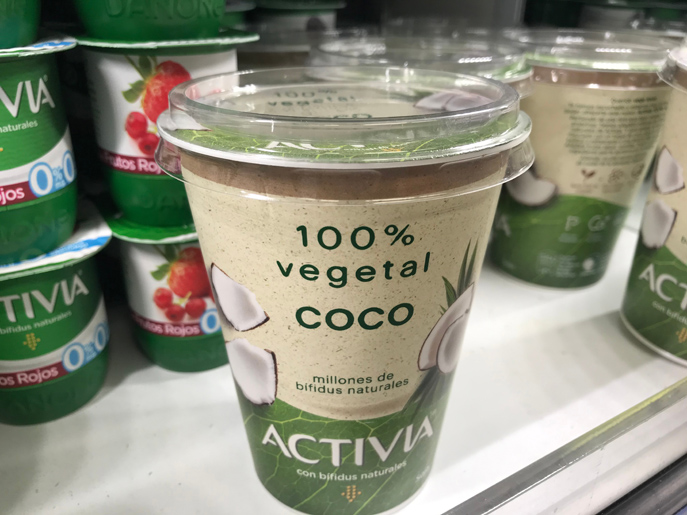Angeli Mehta reports on how companies like Danone, Unilever, and China's Cofco International are addressing biodiversity loss through platforms like the Business for Nature coalition and One Planet Business for Biodiversity
This decade has been billed as the decade of climate action – but it’s not enough to cut carbon emissions, we also have to reverse the precipitous loss of our planet’s biodiversity.
We humans have already altered 75% of land and 66% of ocean environments. More than 85% of wetland areas have been lost. Within our oceans there are huge dead zones, so called because they contain too little oxygen to support life. The suffocation is caused by fertiliser and sewage run off. Meanwhile, fish stocks are at unsustainably low levels.
Earth is on the verge of a sixth mass extinction (the last was 66 million years ago and saw off the dinosaurs) with species vanishing at an unnatural rate, and 1 million likely to be lost within decades. Insect populations are collapsing, threatening the ecosystems they underpin.
Even if we totally convert to renewable energy today, we’ll still need help from nature
The root cause of this catastrophic situation is over-consumption.
“Even if we totally convert to renewable energy today, we’ll still need help from nature,” says Enric Sala, an ocean ecologist with National Geographic and the founder of its Pristine Seas initiative, which has helped create 22 major marine reserves. “We won’t achieve Paris if we continue to cut down forests, or take fish out of the ocean. We have to restore and re-wild much of what we’ve degraded.” A shift to regenerative agriculture would, he argues, improve soil health so that it could absorb much of the excess carbon in the atmosphere.
Sala is leading an effort to push through a global agreement on biodiversity, to be signed by 196 nations this autumn in China. At the heart of the “zero draft” is a science-based target to have at least 30% of land and oceans in a natural state by 2030, and increases of at least a further 20% by 2050, to ensure ecosystem resilience. The EU will put forward its biodiversity strategy later this month, with measures to support deforestation-free supply chains expected later this year.

Global targets on biodiversity were previously set in 2010: 17% of land and 10% of the oceans were to be protected by 2020. “We’re almost there,” says Sala. However, “the targets were purely political, and not based on science. Now we have enough science, we want to prevent the collapse of ecosystems and meet the Paris goals.”
Action is needed at all levels, from a shift to regenerative agriculture to the redirecting of subsidies. “If governments set clear regulations, and a level playing field, companies will innovate. They know being more sustainable is better, but subsidies ingrain the current practices,” he adds.
Last month, delegates from more than 100 countries met for the first round of negotiations on these post-2020 targets. Progress was deemed to be ‘good’ but the key question is funding for implementation, with poorer countries with mega-biodiversity looking for financial support from richer nations. Co-chair Basile van Havre said resource mobilisation would be done in parallel with agreeing targets. Direct support will be important, he said, but costs could be reduced by not creating further degradation and looking at subsidies: “For every dollar we need there is about $10 in negative incentives, so there is a huge potential to redirect and repurpose incentives.”
There’s a lack of broadly agreed metrics, global targets, and gaps in data on biodiversity
Business needs to be on board, says Annelisa Grigg, who until recently led the effort to engage business on biodiversity at the UN’s World Conservation Monitoring Centre (UNWCMC). “We need concerted efforts on how you engage companies – to get their input into the target-setting process and help measure their contributions”. Grigg has set up a new organisation, Global Balance, to build business awareness of biodiversity.
Business has begun to wake up to the scale of the challenge, with some companies coming together to rethink their sourcing models. Research by the World Economic Forum suggests that more than half of total GDP – some $44 trillion – is exposed to nature loss. Industries like construction, agriculture and food and drink are particularly exposed.
Others, including chemical, retail, travel and tourism, have “hidden dependencies” through their supply chains.

In 2018, researchers at Oxford University found that just 49 of the top Fortune 100 companies mentioned biodiversity in their sustainability reports, and only five of them had made biodiversity commitments “that could be considered specific, measurable and time-bound”.
According to Grigg “there’s a lack of perceived materiality; a lack of broadly agreed metrics, global targets and gaps in data [on biodiversity]. That said, none of those should be enough to stop people from acting.”
Part of her work at the UN had been to look at how biodiversity is integrated into natural capital assessment and attempt to place a value on it.
The need for consistent messaging is a lesson learned from business engagement on the climate agenda
Grigg counts 12 approaches to measure biodiversity – both site and product-based – covering different sectors. UNWCMC is trying to seek common ground between the various measures but there is tension, because the measurements need to be science based.
Farthest ahead is the Global Biodiversity Score, developed by CDC Biodiversité and now being piloted by 35 companies. The tool will be released in May. The initiative is driven by a French government commitment to get companies to report on their biodiversity footprint. In the UK, the Department for Environment, Food and Rural Affairs (Defra) is beta-testing a biodiversity metric for developers and planners.
Businesses are taking part in a few coalitions working towards October’s global biodiversity conference. The Business for Nature coalition of business and conservation organisations aims to coordinate an aligned message from the business community, with five recommendations for policymakers.

Wei Peng, global head of sustainability at China-based Cofco International, says the need for consistent messaging is a lesson learned from business engagement on the climate agenda.
Those policies, she adds, need to break the silos between climate change, biodiversity loss and human welfare and create concrete and time-bound implementation plans.
Another part of the jigsaw is One Planet Business for Biodiversity (OP2B), a cross-sector coalition of businesses focused on transforming their agriculture supply chains to restore biodiversity.
There is a pledge fatigue. People want to know exactly what you are going to change
“We’ve learned from climate that we need to work together more quickly,” says Diane Holdorf, managing director for food and nature at the World Business Council for Sustainable Development (WBCSD), which is hosting the 19 members of OP2B.
In its launch materials OP2B acknowledges that efforts to make agriculture more efficient and productive have led to biodiversity loss on farms; a degradation of ecosystems and a lack of ingredient biodiversity in our diets. It points to findings from the UN Food and Agriculture Organization (FAO) highlighting that just nine plant species – out of 66,000 that are grown for food – make up two-thirds of total crop production.

Eric Soubeiran, vice president, nature and water cycle at Danone, says OP2B will focus on three areas: transforming sourcing models to foster soil health and regenerative agriculture at scale; using product portfolios to purchase more diverse ingredients; and reducing deforestation and promoting high-value ecosystems.
The objective is to have a set of actions that can be monitored. “There is a pledge fatigue. People want to know exactly what you are going to change,” Soubeiran says. “It could be that we say, for example, in Indonesia we will commit to protect this number of hectares of rainforest by having corridors of biodiversity, and put in place in this palm oil area these regenerative practices that will give farmers diversification of revenue. So when you look at the before and after, you should be able to monitor the impact – not just percentages. It has to be grounded somewhere and visible.”
If we think about the potential for improved soil health, we should all invest – but how do we make investments credible?
Holdorf says big questions need to be addressed: “If we think about the potential for improved soil health to help farmer livelihoods and sequester carbon, we should all invest – but how do we make investments credible and long term?” Crucially, “farmers need to be part of the conversation.”
Both Danone and Unilever are working with US farmers on soil health. Danone has a soil research programme with 23 dairies across 50,000 acres and is beginning to map the economic impact of soil health practices. It has teamed up with an impact investing firm rePlant Capital to provide low-cost loans to farmers that are working on organic or regenerative conversion.
Unilever is also working with US soy farmers and soy oil producers, who supply products like Hellmann’s mayonnaise, to increase the use of cover crops after harvesting. These crops help slow soil erosion and keep nutrients in the ground until the next growing season. Moreover, healthy soils sequester carbon.

But many farmers will be smallholders in the developing world, who’ll need access to finance and knowledge. Peng says Cofco has started to invest in technical assistance for farmers in the areas of land conservation and responsible use of inputs.
It has also been restoring native vegetation around sugar plantations in Brazil, planting more than 1.6 million seedlings, and cutting fertiliser use by applying sugarcane residues to fields. There have been obvious environmental benefits says Peng. “What’s more, they have proven to deliver tangible business value for the company, in terms of resource efficiency, productivity and community relations.”
Soubeiran insists Danone’s direct soy sourcing is completely deforestation free, but indirect sourcing (through soy used to feed cattle) is problematic. “You have weak traceability in Europe for soy arriving from Brazil, but we are working hard – we’re prepared to pay the right price so long as there is real traceability and real transition towards more regenerative practices.”
The concept of physically segregating supply chains, unless you own the entire chain, is, for many buyers, meaningless
Toby Gardner, senior research fellow at the Stockholm Environment Institute, says while data can be key in driving change, change can be made without waiting for the most detailed data.
Because soy and palm oil from different farms are each bulked together, “the concept of physically segregating supply chains – unless you own the entire supply chain – is, for many buyers, meaningless.”
Gardner is director of Trase, an initiative that, with creative thinking and a good deal of detective work on publicly available records (like shipments and warehousing), has come up with a means to entirely map the patterns of movement between the regions of commodity production, and the regions of import.

Trase has mapped almost all of the Brazilian soy chain, so buyers can identify the hotspots of deforestation and take action by changing sourcing patterns, or (far better) to get involved to improve conditions on the ground. To have a positive impact, he says, “companies need to care about how much deforestation is linked to an entire sector. If a company just moves or changes to a different crop, that may not impact on deforestation.”
The data can also be used for better accountability, to assess whether sustainability commitments are being met. The Trase team is already working with supermarkets such as Tesco, Waitrose and Carrefour; the French government; and banks like Santander who want to profile deforestation risk on their loans portfolio. In Indonesia, work with partnerships involving local government, palm oil producers and civil society groups “can help them understand which markets they’re connected to and which brands might make the commitment to help them improve.”
Human civilisation was built in an era of climate stability. That stability was based on biodiversity
Holdorf believes we’ll begin to see concrete progress this year, with a menu of meaningful actions that can be implemented by OP2B members in their supply chains by June. She’s part of a group working on “apex goals” that would contribute to national biodiversity loss reduction targets – similar to the national defined contributions of the Paris climate agreement – and feed into October’s Biodiversity COP.
What’s at stake is our very survival on this planet. “Human civilisation was built in an era of climate stability,” says National Geographic’s Sala. “That stability was based on biodiversity.”
Angeli Mehta is a former BBC current affairs producer, with a research PhD. She now writes about science, and has a particular interest in the environment and sustainability. @AngeliMehta.
This article is part of our in-depth Deforestation briefing. See also:
Tendrils of hope amid huge setbacks for sustainable soy in Brazil
‘With the right incentives we could double soy production without felling another tree’
Mato Grosso’s plan to halve land use for cattle in bid to curb deforestation
‘Extreme poverty still fueling deforestation in Africa’
‘Investors and companies are fiddling while forests burn’
Is FSC worth the paper it’s printed on?
Standoff at Rainbow Ridge as northern California tree protestors take aim at FSC and Home Depot
Tackling deforestation key as UK looks to plough its own furrow post-Brexit
WBCSD biodiversity sixth great extinction Paris Agreement Unilever Danone UNWCMC Global Diversity Score OP2B sustainable soy

